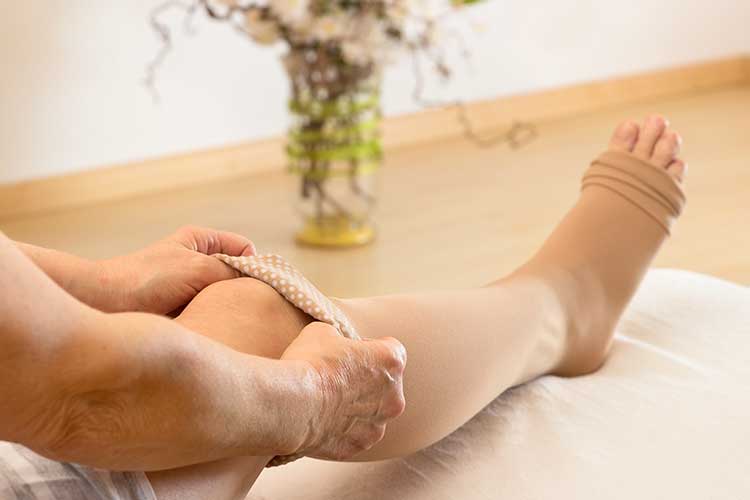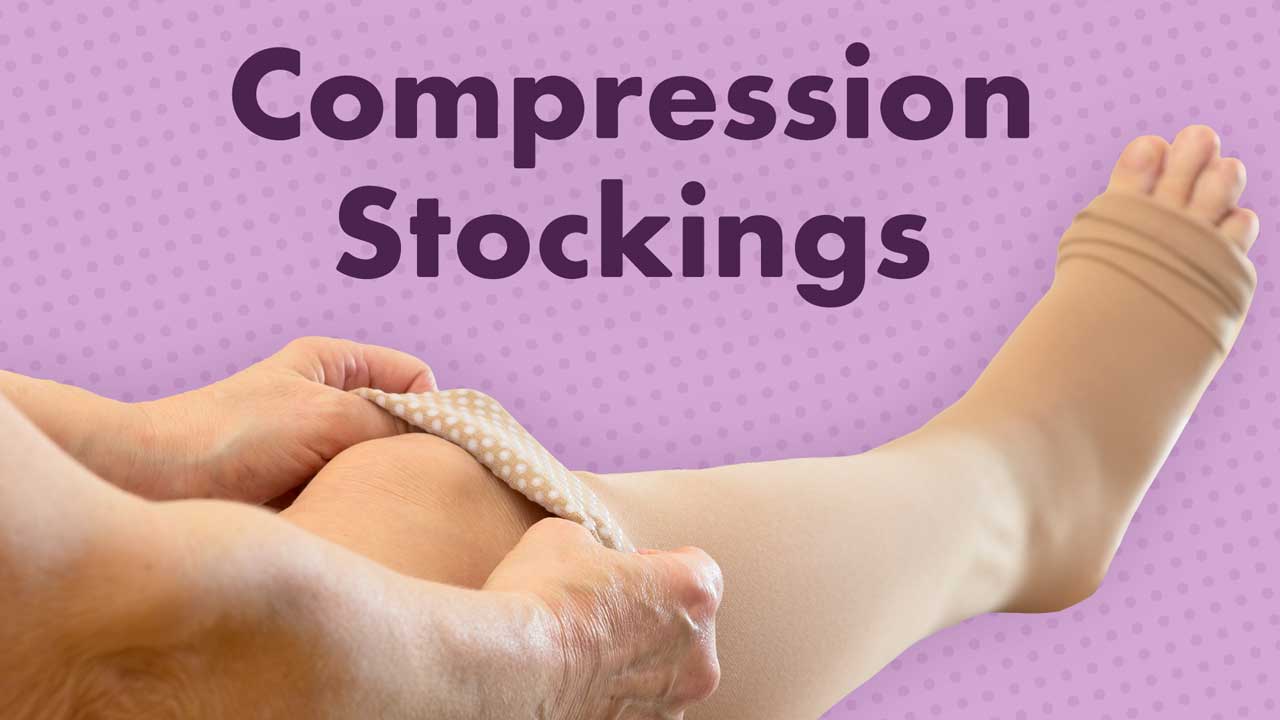Compression stockings are used to treat and prevent a variety of conditions, including varicose veins, lymphoedema and deep vein thrombosis (DVT) (myDr 2024).
Compression stockings work by squeezing the veins and muscles in the leg. The compression is firmest at the ankles and gradually reduces higher up the leg. This helps to improve blood circulation in the legs and reduce swelling by preventing fluid from accumulating in the ankles (myDr 2024).
When not properly applied and cared for, compression stockings may cause complications such as impaired skin integrity and pressure injuries in vulnerable people.
However, with appropriate care and monitoring, these complications are preventable.
This article is intended for all healthcare staff who are required to apply, remove and care for people requiring the use of compression stockings.
Before Applying Compression Stockings:
Examine the area where the stocking will be applied, assessing for:
- Neurovascular status
- Pain and sensation
- Certain wound management products that are unsuitable for use under compression (e.g. hydrocolloids, thick dressings)
- Skin integrity
- Wounds (these should be treated appropriately)
- Skin issues such as itching, eczema, dryness, maceration, excoriation and allergic reactions
- Arterial compromise
- Signs of infection (e.g. limb is red, painful, swollen or hot).
(SESLHD 2024; Derbyshire JAPC 2021)
Note: Do not apply compression if the client and/or their carer will be unable to remove the garment independently if an issue occurs (SESLHD 2024).
How to Apply Compression Stockings
Stockings should generally be applied first thing in the morning, as this is typically the time of day when the legs are the least swollen (Kingston and Richmond NHS Foundation Trust 2024).
Note: Rings, jewellery or other sharp objects must not be worn when applying compression stockings. Fingernails should be short (Derbyshire JAPC 2021).
Compression Stocking Applicators
Compression stocking applicators are plastic structures that are used to assist with fitting pressure stockings.
How to use a stocking applicator:
- Seat the client.
- Put the applicator on an appropriate surface for preparation. The elongated hole should be facing you.
- Put the stocking inside the ‘U’ shape. The heel of the stocking should be facing the elongated hole.
- Pull the top of the stocking over the applicator and slide it down the sides.
- Stop pulling once the heel is slightly over the top and in the middle of the ‘U’ shape.
- Place the applicator over the client’s toes and hold the heel pocket as their toes enter the stocking.
- When the heel pocket is in line with the client’s heel, release the heel pocket of the stocking.
- Keep moving the applicator over the client’s foot. Their heel should slide into the elongated hole as the applicator changes direction around their ankle.
- Pull the applicator towards the client’s knee.
- Once free of the stocking, remove the applicator. If a full leg stocking is required, remove the applicator at the base of the client’s knee and use your hands to pull the upper portion into place.
- Ensure the heel of the stocking is properly positioned.
- Smooth out any wrinkles.
(EzyAs 2020)
Note: Applicators come in different sizes. Ensure the right size is available to fit over the client’s calf. If the applicator is the wrong size, don’t use it and notify clinical staff to provide the right one for the next visit.
How to Remove Compression Stockings
Compression stockings should generally be removed before bed (Kingston and Richmond NHS Foundation Trust 2024). However, ensure that you confirm this with your clinical staff, as different clients have different care needs.
To remove the stocking:
- Pull the stocking down to the client’s ankle, turning it inside out.
- Gently pull the toe portion off the foot.
(Derbyshire JAPC 2021)
Maintaining Skin Integrity
Compression stockings place pressure on the limbs and pressure points, and have the potential to cause skin breakdowns or contribute to the development of pressure injuries (Robinson et al. 2023).
Despite this, with appropriate care and monitoring, these complications are preventable.
Compression stockings should be removed to check for skin damage four times per day in high-risk clients (e.g. reduced mobility, compromised skin integrity, sensory loss), and at least once per day for all other clients. The client’s ankles, heels and toes should be assessed. The heels and bony prominences are especially susceptible to damage (Canterbury District Health Board 2022).
When assessing the skin, check that the client’s toes are warm, pink and dry from moisture (e.g. water, sweat), which indicates adequate circulation (myDr 2024).
Compression therapy causes the skin to become dry. Skin integrity can be maintained by applying emollients to moisturise the skin once the stocking has been removed (Kingston and Richmond NHS Foundation Trust 2024).
It is important to ensure that the client’s stockings are free of wrinkles, as this may increase pressure. Wrinkles can be smoothed with the palm of the hand (Canterbury District Health Board 2022).
When to Escalate Care
The following abnormalities should be escalated to clinical staff:
- The client’s leg/feet are red, painful, swollen or hot
- The client’s leg/feet are cold, numb or tingling (pins and needles)
- The client’s toes are blue or purple
- Wound exudate is staining the garment.
(myDr 2024; Cleveland Clinic 2022; SESLHD 2024)
Caring for Compression Stockings
Stockings should be washed according to the manufacturer’s instructions, either by hand or on a gentle wash cycle between 30 and 40°C. Fabric softeners should not be used (medi Australia 2020).
Note: The stocking should not be:
- Wrung out
- Twisted
- Hung from a clothesline
- Tumble dried
- Dried over a direct heat source
- Ironed.
(Derbyshire JAPC 2021)
When should the compression stocking be replaced?
- After six months of use, or
- If it becomes too loose or too tight, or
- It develops holes, fraying or ladders.
(myDr 2024; Derbyshire JAPC 2021)
Client Education

About 60 to 70% of people are estimated to be non-compliant with compression therapy (RACGP 2017). This is due to factors such as:
- Discomfort
- Itching
- Tightness
- Pins and needles
- Rashes
- A belief that compression therapy is unnecessary and/or ineffective.
(RACGP 2017)
Educating the client about the importance of compression therapy and establishing a positive therapeutic relationship with them is essential for effective treatment (RACGP 2017).
Other strategies to encourage compliance include:
- Find out whether the client is happy with the colour of their stockings (some people may prefer black stockings instead of flesh, for example)
- Ensure that the client understands the reasons for wearing compression stockings
- Ensure that the stocking is a correct fit and is not causing discomfort
- Have a discussion about the client’s past experience with compression stockings and show empathy and understanding.
(RACGP 2017)
Manual Handling Considerations
The application of compression stockings requires significant exertion of pulling force, as well as static loading (being in the same position for four seconds or longer) (Wright & Campbell 2020). In order to prevent injury, you should:
- Instruct the client to sit with their hips flexed (e.g. on a firm bed or sofa), as this position is easiest for applying and removing stockings
- Adjust the bed/chair to an appropriate height
- Avoid bending over forwards for extended periods of time - stand upright and stretch your back regularly
- Consider using a compression stocking applicator.
(Wright & Campbell 2020)
Note: This article is intended as a refresher and should not replace best-practice care. Always refer first to your organisation's policies and procedures on compression stocking application, removal and care.
Test Your Knowledge
Question 1 of 3
Which one of the following is NOT recommended when washing compression stockings?
Topics
Further your knowledge
References
- Canterbury District Health Board 2022, Graduated Compression Stockings (TED’s), Canterbury District Health Board, viewed 26 June 2025, https://edu.cdhb.health.nz/Hospitals-Services/Health-Professionals/CDHB-Policies/Nursing-Policies-Procedures/Documents/Graduated-Compression-Stockings-%28TED%27s%29.pdf
- Cleveland Clinic 2022, Compression Therapy, Cleveland Clinic, viewed 26 June 2025, https://my.clevelandclinic.org/health/treatments/23449-compression-therapy
- Derbyshire Joint Area Prescribing Committee 2021, Guidelines for the Use of Compression Hosiery, National Health Services, viewed 11 February 2025, https://www.derbyshiremedicinesmanagement.nhs.uk/assets/Clinical_Guidelines/Formulary_by_BNF_chapter_prescribing_guidelines/Appendix_5/Compression_hosiery.pdf
- EzyAs 2020, EzyAs Instruction Guide, EzyAs, viewed 26 June 2025, https://ezyasabc.com/wp-content/uploads/2020/05/EZY14720_Instruction-Booklet_8pp_FA02.pdf
- Kingston and Richmond NHS Foundation Trust 2024, Compression Socks and Stockings, National Health Service, viewed 11 February 2025, https://www.kingstonandrichmond.nhs.uk/patients-and-families/patient-leaflets/compression-socks-and-stockings
- medi Australia 2020, Caring for Compression Garments, medi Australia, viewed 26 June 2025, https://www.mediaustralia.com.au/faq/compression-garments/caring/
- myDr 2024, Compression Stockings, myDr, viewed 11 February 2025, https://www.mydr.com.au/skin-hair/compression-stockings/
- Robinson, H, Atkin, L & Gray, S 2023, ‘Medical Device-related Pressure Injury From Compression Therapy’, British Journal of Nursing, vol. 32, no. 20, viewed 26 June 2025, https://www.magonlinelibrary.com/doi/abs/10.12968/bjon.2023.32.Sup20.S30
- Royal Australian College of General Practitioners 2017, ‘Compression for Venous Leg Ulcers’, Handbook of Non-Drug Interventions (HANDI), RACGP, viewed 26 June 2025, https://www.racgp.org.au/clinical-resources/clinical-guidelines/handi/a-z/c/compression-for-venous-leg-ulcers
- South Eastern Sydney Local Health District 2024, Wound – Graduated Compression Therapy (GCT) in Venous Disease, New South Wales Government, viewed 30 June 2025, https://www.seslhd.health.nsw.gov.au/policies-and-publications/functional-group/90
 New
New 

